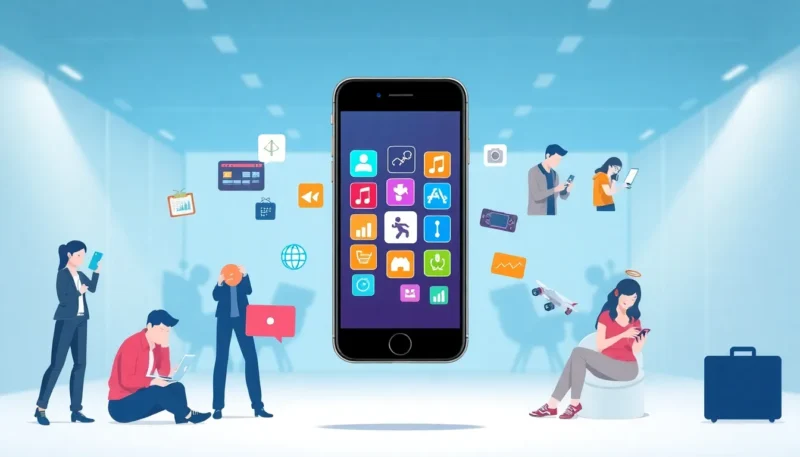
In a world where everyone has a smartphone and social media notifications pop up faster than you can say “mobile app,” it’s no surprise that mobile applications have infiltrated our daily lives. From ordering your morning coffee to tracking your fitness progress, mobile apps have transformed how we interact with technology. But what exactly are mobile apps? Are they just glorified calculators or something much more? Don’t worry: we’ll take you through everything you need to know in this enlightening read, peppered with a pinch of humor to keep those eyelids from drooping.
What are Mobile Apps

Mobile apps, short for mobile applications, are software programs designed specifically for mobile devices like smartphones and tablets. Unlike desktop applications, which are made for computers, mobile apps can be downloaded from app stores for platforms such as Android and iOS. Think of them as the little all-stars of the digital world, performing tasks that bring convenience and entertainment right to the palm of your hand. Whether it’s a game, a social networking tool, or a banking service, mobile apps create a seamless experience for users on the go.
Types of Mobile Apps
Mobile apps come in three main flavors:
1. Native Apps
These are built for a specific platform using the platform’s native programming languages, such as Swift for iOS and Java for Android. Native apps provide high performance and a better user experience since they can take full advantage of the device’s capabilities, like the camera and GPS.
2. Web Apps
Web apps, on the other hand, don’t require downloading from an app store. They run on web browsers and are built using HTML, CSS, and JavaScript. But, they can’t tap into all features of a mobile device, which can be a drawback.
3. Hybrid Apps
Finally, hybrid apps combine the best of both worlds. They operate like native apps while being built on a web technology stack. Essentially, they allow developers to create one app that works across multiple platforms, making them a cost-effective solution.
Development Process for Mobile Apps
The journey of a mobile app from concept to download involves several steps:
- Ideation: This is where the magic begins. Developers brainstorm ideas and identify the target audience’s needs.
- Design: Next comes wireframing and UI/UX design. This is where the look and feel of the app take shape, think of it as the app getting dressed for a big event.
- Development: Here, programmers write the actual code. This is where native, web, or hybrid specs come into play.
- Testing: Developers rigorously test the app to ensure it runs smoothly. Bugs are squashed like pesky insects.
- Launch: After tests are passed and everything looks good, the app is launched on app stores.
- Maintenance: Once live, the app requires ongoing updates and support to keep it user-friendly.
Key Features of Mobile Apps
So, what makes mobile apps so special? Here are some key features:
- User-friendly Interfaces: Navigating a mobile app should be as easy as pie, every tap should feel intuitive.
- Interactivity: Unlike static websites, mobile apps offer interactive elements, including push notifications and personalized content.
- Offline Capabilities: Many mobile apps allow users to access content even without an internet connection, enhancing user experience.
- Security: With sensitive information at stake, robust security measures such as encryption are critical in app design.
Benefits of Using Mobile Apps
Mobile apps offer numerous benefits to both users and businesses:
- Convenience: Need a ride at 2 a.m.? There’s an app for that. Mobile apps allow users to perform tasks quickly.
- Increased Engagement: Push notifications can bring users back to the app, while user data helps personalize their experience.
- Improved Brand Visibility: Having an app means users have your brand literally at their fingertips.
- Enhanced Customer Loyalty: A well-designed app can foster stronger relationships with customers, encouraging repeat use.
Challenges in Mobile App Development
Developing a mobile app isn’t all fun and games: challenges lie in wait:
- Device Fragmentation: With multiple device types and operating systems, ensuring compatibility is a Herculean task.
- User Retention: Just because someone downloads your app doesn’t mean they’ll keep using it. Keeping users engaged is critical.
- Security Concerns: Data breaches are a reality. Developers must carry out top-notch security measures to protect user data and maintain trust.
Future Trends in Mobile Apps
The mobile app landscape is ever-changing, and staying ahead is essential. Look out for:
- Artificial Intelligence (AI): From chatbots to predictive analytics, AI is becoming integrated into apps, tailoring experiences to individuals.
- 5G Technology: With faster internet speeds, apps will be able to offer even richer experiences, like high-quality streaming.
- Augmented Reality (AR): Remember Pokémon GO? Demand for AR apps is on the rise, bringing virtual elements into the real world.
- Wearable Integration: With smartwatches and fitness trackers booming, apps that seamlessly integrate with wearables will become increasingly popular.












